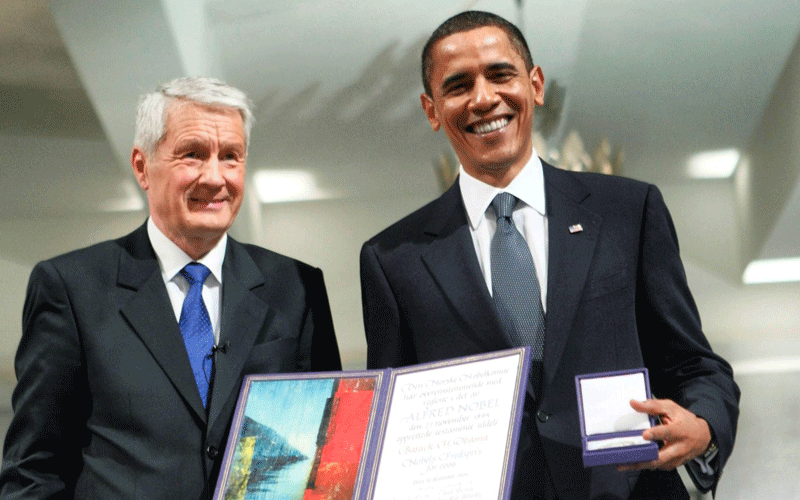Yes We Can, slogan that popularised Obama and the killing of Bin Laden

Bouyed by the promise of hope, and Barack Obama’s campaign slogan, ‘Yes We Can!’ Americans voted in the son of a Kenyan man and American mother as the 44th President of the United States.
The election itself was not only historic but also energised the world into believing that a new beginning and a better world order was possible.
As the world was still savouring the moment, though, Obama and his family made their way back to Chicago to collect their personal belongings before heading back to Washington, where the President-elect embarked on the difficult task of putting together a team that would help him run the government once he assumed office.
“Some of my preferred choices for cabinet positions declined or didn’t pass vetting,” he writes in his latest memoir, A Promised Land, the first volume of which was released on Tuesday.
It did not help matters that he was taking over in the middle of a recession. That meant fixing the economy was the most urgent task he had to put his mind to.
Obama recalls that during the first meeting with his economic team, one of his appointees opened the meeting by declaring: “Mr President-elect, this is your holy-shit moment.”
His job had been cut out for him and he had no choice but to roll up his sleeves and get down to work with an eye on ensuring a quick fulfillment of some of the easier election pledges he had made on the campaign trail.
Economic briefings
“Outside of economic briefings, I was spending much of my transition time in windowless rooms, getting the classified details on Iraq, Afghanistan, and multiple terrorist threats,” he writes.
In the end, all the early preparatory work paid off when, less than a month after Obama was sworn in, his administration had passed a Bill paving the way for revival of key industries that would turn around America’s declining economic fortunes.
Although it got support from both Democrats and Republicans and was hailed as a bi-partisan approach to national problems, Obama says the model his team used to get the Bill passed was far from ideal and not as rosy as the media had painted it.
On the security front, within months, he and his team would come up with a new strategy to combat terrorism in the Middle East, including a change in the military command.
That also meant overhauling the strategies that had been put in place by the George W. Bush administration, which had spent more than $1 trillion in the war against terrorism without having too much to show for the humongous bill and the big number of soldiers in Iraq, Pakistan and Afghanistan, where Al-Qaeda had strong cells and where Osama bin Laden, the terrorist group’s mastermind, was hiding in the mountains of Tora Bora.
“It’s a truism that a president’s single most important job is to keep the American people safe,” Obama writes, explaining why it was necessary to take military action beyond the US borders. But even as he had to do this, he had to learn to walk while also chewing gum.
For decades, the world has looked up to America for leadership and Obama felt compelled to step up and play the role of a global leader.
However, no sooner had he started attending global summits, such as the G20 meetings, than he quickly learned that there was a template to the meetings and not much was expected to be achieved once the leaders went back to their countries.
He also learned that many of the leaders brought their personal quirkiness to the meetings. France’s Nicholas Sarkozy, for instance, “was all emotional outbursts and overblown rhetoric”, Obama says of him.
German’s Angela Merkel, on the other hand, “was famously suspicious of emotional outbursts or overblown rhetoric”. She was initially skeptical about Obama.
The new president also quickly learned that he could advance the American agenda with greater ease if he pulled leaders aside for private meetings than when he lobbied them on the floor.
Thus, in meeting with members of the North Atlantic Treaty Organisation (NATO) and European leaders, he secured support for his military strategy in the Middle East and Pakistan.
The first test would not be long in coming for Obama. Within months of his presidency, Somalia pirates hijacked an American ship and took its captain hostage.
During the drama that would last five days, the four pirates demanded a $2 million ransom to release the American.
On the last day, however, and on Obama’s express orders, they were taken out by SEAL snipers and the captain was freed.
“An early military victory for Obama,” the Washington Post reported the next day.
“That part of my job involved ordering people to be killed wasn’t a surprise, although it was rarely framed that way,” he says.
It is a job, as the book makes clear, that he would on many occasions be called upon to do.
So it came as a surprise to him when, very early on the morning of October 9, 2010, one of his key staff members, Robert Gibbs, called him to break the news that he had been awarded the Nobel Peace Prize.
“For what?” he asked. His wife Michelle asked what the call was about, and when Obama told her, she just said it was wonderful news and promptly went back to sleep.
At a press conference later that day, Obama told journalists that he did not feel he deserved the prize considering that he had not even chalked up a year in the White House.
“I saw the prize as a call to action, a means for the Nobel committee to give momentum to causes for which American leadership was vital,” he writes.
Obama understood that war was both terrible and sometimes necessary and this duality influenced his acceptance of the prize when he travelled to Oslo to accept it.
Despite the heady days and the celebrations, he was still weighed down by the fighting that was going on in Iraq and Afghanistan, where American troops were heavily involved and where, months later, Republicans would accuse him of not doing enough despite his decision to send more troops there.
From the start, he had made it clear he would give priority to bringing Osama to justice over the September 11 attacks in which more than 3,000 Americans were killed.
“There were the obvious reasons for my focus on bin Laden,” Obama writes.
“His continued freedom was a source of pain for the families of those who’d been lost in the 9/11 attacks and a taunt to American power.”
However, Obama also saw the elimination of Osama as an opportunity to turn around the American government’s response to terrorism.
So when the Central Intelligence Agency (CIA) informed him that they had a potentially good lead on where Osama was hiding in Abbottabad, Pakistan, Obama was more than interested.
“I decided we had enough information to begin developing options for an attack,” he writes.
Situation Room
On the day Osama was to be “taken out”, Obama and key members of his administration, the military and intelligence units converted the Situation Room in the White House into a war room, from where they were to co-ordinate the operation.
Already, preparations had been made for the al-Qaeda mastermind to be given an Islamic burial in the event he was killed in the raid.
At around 3.30pm, American time, on May 2, 2011, the operation was already in progress and Obama, rejecting the chair offered by the military officer in charge of the operation, took a side seat to watch the unfolding action.
“It was the first and only time as president that I’d watch a military operation unfold in real time,” he writes.
“Geronimo ID’d… Geronimo EKIA,” the crack SEAL team informed the War Room, meaning that Osama – code-named Geronimo for the operation – had been identified and shot dead.
“We got him,” Obama said softly. Osama had been neutralised. His “elimination” led to celebrations all across America.
The one thing that Obama appears to have learned from Republicans, as he says in his book, is that they understood that “in politics, the stories told were as important as the substance achieved”.
Has he told the first part of his story as president well? Without a doubt. It is not just all history and achievements and numbers.
It is a human story, touching at every level, humanising the men and women he worked with, first to win the presidency and later, to do the actual hard work.
His is also a family story, revealing, every step of the way, how his wife and daughters handled every aspect of Obama’s transition from just another senator to the most powerful politician in the world.
And what a journey that turned out to be, one that filled many people across the globe with hope and an unshakeable belief in the beauty of possibilities!
It is also one which, despite his best efforts, also reveals his missteps as well as his spectacular failures. — The writer is a partner and Head of Content at House of Romford. mbugua@houseofromford.com









